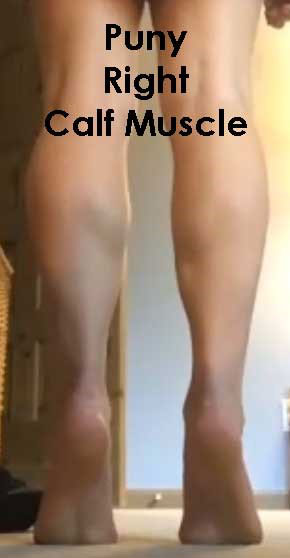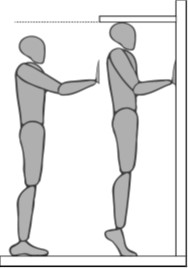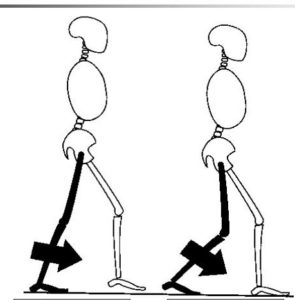Puny Calf Muscles Syndrome

Avoiding puny calf muscle syndrome is important for a multiplicity of reasons. Strong flexible calf muscles are important for health and wellness.
Your calf muscles propel you forward with every single step, they absorb load with each impact, and they support the rest of your lower limb and body.
Musculoskeletal Pain Syndromes: Small weak calf muscles are factors in numerous musculoskeletal pain syndromes painful such as: plantar heel pain; shin pain; stress fractures; Achilles pain, knee pain (anterior knee), hip pain (anterior hip/groin), hamstring pain (late in stance phase of gait); and back pain.
The muscles responsible for hip extension (gluteal muscles) are synergistic with muscles responsible for ankle plantar flexion (calf muscles). Commonly one muscle group will compensate and work harder for an adjacent muscle group which is relatively weak and impaired.
If you have painful hip joint the calf muscles can help propel forward. Conversely, if your weak gluteal muscles compensate with more ankle plantar flexion this may lead to Achilles pain.
If you have Achilles pain, gluteal muscles can propel your forward. Conversely if your weak calf muscles compensate with more activity in the gluteal muscles this may lead to hip/buttock pain.
If you are suffering with osteoarthritis of the hip or knee, strengthening the calf muscles can help keep you from seeing a surgeon. If you have already had surgery for osteoarthritis of the hip or knee (joint replacement) strengthening the calf muscles can help. Recovering from total hip or knee replacement surgery aggressive strengthening exercises for calf muscles help restore normal walking.
Running: Strong calf muscles are especially important when it comes to running. Anthony Schache of University of Melbourne suggests running speed can be increased by pushing on the ground more forcefully, pushing on ground more frequently or by using both strategies. When increasing speed from walking to running pushing on the ground more forcefully is the primary strategy. Calf muscles are critical for running activities. Richard Neptune has shown the calf muscles serve an important role in the transition from walking to running. Samuel Hammer of Stanford University showed calf muscles are major contributor to acceleration when running. Balint Kovacs showed larger calf muscles are correlated with better marathon running performance. For the aging athlete maintaining and improving calf muscle strength is critical.
Risk of falling: Walking speed predicts both functional and physiological changes and has been called the 6th vital sign. As we age, we slow down. As we age our risk of falling increases. Older individuals who fall may fracture bones, lead to disability, nursing homes admission, and even death. Strength of calf muscles is major determinant of how fast older adults walk. This process of calf muscle weakness, walking slow, and falling can be reversed with therapy.
How to determine the magnitude of puniness - calf muscle weakness? The standard measurement of calf muscle strength is the heel raise test which is described here, here, and here.

Heel raise test both legs and/or one at a time.
Image from: Calf-raise senior: a new test for assessment of plantar flexor muscle strength in older adults: protocol, validity, and reliability, by Helô-Isa André, in Clinical Interventions in Aging
In addition to static heel raise strength measurements gait analysis can identify deviations associated with calf muscle weakness. Weak calf muscles will manifest as diminished propulsion up and forward when walking and running. The primary gait deviations of a weak calf muscle are a prolonged heel contact late in the stance phase of walking or running.

Prolonged heel contact (heel stays on ground beyond the moment the opposite foot is on ground) & excessive knee flexion late in stance
Image from Gait Analysis by Jacquelin Perry
During normal walking, the heel should come off the ground just prior to the foot contact of the opposite limb. Slow motion video recording facilitates determining when heel coming off the ground is occurring. When walking if the sole of foot or shoe stays on ground beyond the moment the opposite foot strike is occurring it is considered deviant not normal.
Secondary signs of weak calf muscle when walking or running are either a hyperextension or hyperflexion of the knee at terminal stance. The gait has the appearance shuffling as opposed to walking/running with spring in the step – decreased up down motion of body/head.
What to do for puny calf muscles: It is time to replace the common belief that stretching exercises should occur before exercise or sporting activity with a newer concept that strengthening exercises for the calf muscles should occur before exercise or sporting activities. Stretching exercises does not prevent injury, but calf strengthening exercise may.
During warm up for exercise and sporting activity make a conscious effort to walk with spring in your step.

Walk like you a trying to peer over a fence or peer over someone who is walking in front of you. Include tip toe walking, skipping, rope jumping in warm up engages and strengthens the calf muscles.
If your self-assessment is that you have puny calf muscles and wish to remediate the impairment a Physical Therapist can help. A Physical Therapist can design a specific individualized strengthening program if you have questions like:
- How weak or puny are my calf muscles compared to normal and what should my goal be?
- Should heel raise exercises be thru the range of motion, or focused on the top of the range of motion?
- How do I modify the heel raise if heel raise exercises aggravates my knee, hip, or back pain?
- Should the knees be straight, bent, or both?
- Should the toes be pointed straight ahead, toe in; toe out; or combination?
- When to progress to faster functional strengthening activities like skipping, hopping, and rope jumping?
Reactivating and reversing puny calf muscles can prevent injury, increase athletic performance, forestall old person shuffle, and look better.
The information on this website is not intended or implied to be a substitute for professional medical advice, diagnosis, or treatment. You are encouraged to perform additional research regarding any information contained on available through this website with other sources and consult with your physician.
Damien Howell Physical Therapy – 804-647-9499 – Fax: 866-879-8591 At-Home, At Office, At Fitness Facility – I come to you, I do home visits Damien@damienhowellpt.com
